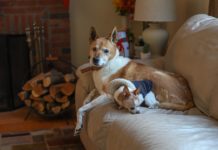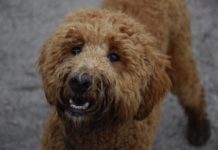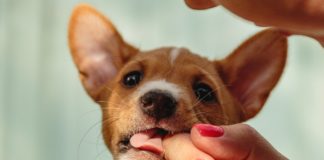Doggy parents often wonder why their dogs seem to enjoy chewing on wood, whether it be in the garden or in the kitchen. While chewing on an item like a tree branch or a small log, is a common game we enjoy seeing our dogs doing, chewing on wooden items such as a wooden spoon can leave you pretty unhappy with your dog. Have you just come home only to find your dog has chewed on a wooden spoon? If so, then continue reading!
Many dogs seem to have an obsession with chewing on wood, regardless of its physical form. Your dog’s preference to chew on wood can be a sign of underlying health and behavioral issues.
Why Do Dogs Eat Wooden Objects?
There’re a few possible reasons why your dog may eat at items like a wooden spoon. Let’s have a look at some of the most common reasons your dog is chewing or eating at wood:
It’s natural: chewing is a big part of being a dog, especially younger dogs, as they use their mouths to learn about their environment. It’s also common for young dogs to ease the pain caused by teething, by chewing.
Boredom: if a dog has been left alone for long periods, or isn’t getting much attention, then they can become bored and start chewing/eating wood. As dogs need something to do, something to work on, wood is a great soother as it helps to burn lots of energy as they chew.
Separation anxiety: another possible cause of chewing and eating wood. This is closely tied in with boredom. When a dog gets stressed from being left alone for long periods of time, they may try to seek relief through destructive behaviors, such as chewing on a wooden spoon. Chewing on an item like this helps to ease their anxiety.
As you can see, there’re a lot of reasons as to why your dog could be chewing on a wooden spoon, including easing the anxiety of boredom and being left alone, younger dogs/puppies teething and just natural curiosity. However, there’s another reason why your dog would turn to chewing on wooden items—it’s called pica.
Dogs that have a habit of chewing on wood may experience stomach issues from eating wooden objects. The ingestion of non-food items can severally affect a dog’s health, which is why it’s important to teach them to leave it. It’s possible that your dog may suffer from nutritional deficiency and look for things to compensate. Ask your vet for more advice.
Dog Pica
Pica is a common eating disorder that can affect dogs and even dog owners. It’s a compulsive eating disorder that leads dogs (or humans) to eat things that aren’t considered food. Examples include dirt, clay, wood, glue, hair, and more. Pica can be caused by malnutrition, intestinal parasites, or boredom or separation anxiety. A dog that eats wood could be due to a vitamin deficiency. Pica could be harmful if a dog eats items that could damage its digestive system. Pica can also cause choking, and poisoning.
Common signs and symptoms of pica include:
- Diarrhea
- Vomiting
- Loose stools
- Chronic bad breath
Serious symptoms of pica, like an intestinal blockage, include:
- Straining during bowel movements
- Dark stools
- Burping
- Excessive drooling
- Abdominal contractions
- Inability to produce stools (constipation)
My Dog Ate A Wooden Spoon What Should I Do?
First off, don’t panic straight away, especially if your dog has only chewed a few pieces of the wooden spoon. There’s a good chance that they’ll be ok. Although, if your dog ate quite a bit of the item, then it’s recommended to call a vet and get your dog in to see them. One concern could be that an item like a wooden spoon can easily splinter, which means small, jagged or sharp pieces could cause injuries somewhere in the dog’s digestive system.
How to Keep A Dog From Eating Wooden Items?
Monitor your dog: make sure to monitor your dog when they’re close to wooden accessible items either in the house or in the yard. That way, you can quickly move in if they start to chew on wooden items.
Anti-chew spray: can also be helpful, although there are some dogs that don’t seem to care about the spray and will chew, anyway. There are products out there like the Anti Chew Spray Deterrent for Dogs. While the spray is meant to be used as a training tool, it can also help to keep your dog away from wooden items.
My Dog Won’t Stop Chewing Wood
While some of the methods used above work, they can be impractical for items such as kitchen utensils. Therefore, you may need to try these alternative methods to help prevent your dog from eating wooden items:
Negative Reinforcement
If your dog starts to approach a wooden item, then quickly say “no.” You’ll need to do this every time they begin to approach or eat the item. However, you shouldn’t strike or swat your dog for eating wood, as this may only make the behavior even worse and your dog could do it more.
Take It Away
If you’ve found your dog with a wooden item in its mouth or is in the act of chewing the wood, then say “no” firmly and take the item away. You can also train your dog to drop the wood. Be sure to give your dog a suitable substitute to chew on right away.
Use A Pet Cam
If you find that your dog’s chewing on wooden items while you’re away at work, then it may be helpful to install a pet camera or a device like the PetCube. That way, you can check on your dog throughout the day and scold them if they start to chew or eat wood things. The good thing with the PetCube is that it lets you chat with your dog, hear their response and more.
While chewing on wood may seem like a harmless activity; it can be quite harmful to your dog and your home. If you’re dealing with a young puppy, that’s teething. It’ll be necessary to help them learn to chew on more appropriate items. For adult dogs, you’ll need to also help them learn to chew on the right types of items like dog toys and treats. However, if your dog persists to chew or shows signs that eating wood has caused a medical problem, it’s at this stage a good idea to have your dog checked out by the vet. The vet can then determine if the chewing is a behavioral problem or due to an underlying medical condition.








